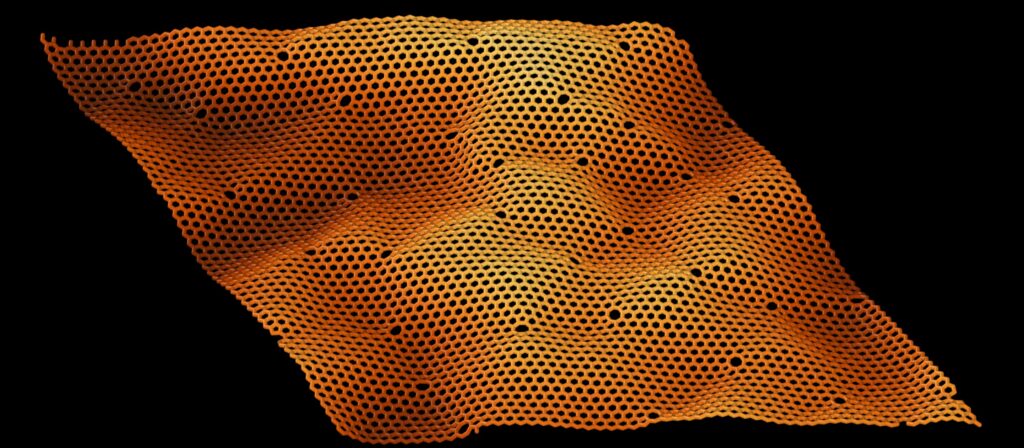Defects in two-dimensional materials (such as an atom-thick sheet of graphene) can dramatically alter the way that the surface ripples, even stopping the sheet in place like a freeze frame.
Rippling is a crucial property of 2D materials and influences strength, conductivity, chemical activity and fluid interactions. Understanding the relationship between rippling and defects is essential for key technologies such as flexible electronics, energy storage, catalysis and nanofluidics. New research on this topic is published in PNAS.
Dr. Fabian Thiemann, the first author of the paper, started this research during his Ph.D. between UCL, the University of Cambridge and Imperial College London, and is now a Research Scientist at IBM.
He said, “While experiments can capture the overall shape of rippled membranes, they struggle to resolve how these structures evolve at the atomic scale over time. Our simulations bridge this gap, allowing us to track the rippling dynamics in detail and uncover the role of microscopic defects in shaping the material’s morphology.”
Frozen ripples
Two-dimensional materials are at the forefront of technological research, such as in ultra-thin flexible screens, faster electronics, and water filtration. What may seem like a flat surface, though, is never truly flat at the atomic level. Like a pond, these 2D surfaces have tiny ripples that affect their properties.
The researchers used machine learning-based computer models that represent 2D sheets of graphene and other materials. With these models, they can observe the rippling behavior of different materials with and without defects. They found that defects in the sheet affect the way that ripples move, and most crucially, that above a certain concentration, the defects freeze the membrane and it loses its flexibility.
Professor Angelos Michaelides in the ICE group at the Yusuf Hamied Department of Chemistry at the University of Cambridge commented, “The wholescale impact such a small proportion of defects can have on the dynamics of graphene is remarkable. The prospects for exploiting these new fundamental insights are exciting and numerous, particularly in nanofluidics.”
Designing around defects
Dr. Camille Scalliet worked on this project when she was a Herchel Smith Postdoctoral Fellow at the University of Cambridge, and is now a permanent researcher at the Laboratoire de Physique de l’École Normale Supérieure in Paris.
She remarked, “By understanding how defects influence these ripples, our work helps engineers control the physical behavior of these materials by using defects—something traditionally considered undesirable—as a design tool.”
Erich A. Müller, Professor of Thermodynamics at the Department of Chemical Engineering, Imperial College London, added, “This work is a premier example of how machine learning potentials (a sub-discipline of artificial intelligence) are transforming the field of materials science by enabling more accurate, efficient, and data-driven predictions of material properties. This is accelerating materials discovery and design, leading to the development of novel materials with desired functionalities for various applications.”
Looking ahead, the researchers are eager to build on these findings. Reflecting on the future of their research, Fabian Thiemann and Camille Scalliet stated, “There are great ways to continue this work. Our next steps are to study more complicated situations at the nanoscale, such as membranes in contact with water or other materials. This is just the beginning for this collaboration.”


